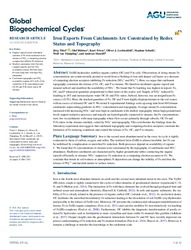Iron Exports From Catchments Are Constrained by Redox Status and Topography
Schuth, Stephan
von Tümpling, Wolf
DOI: https://doi.org/10.1029/2021GB007056
Persistent URL: http://resolver.sub.uni-goettingen.de/purl?gldocs-11858/9815
Persistent URL: http://resolver.sub.uni-goettingen.de/purl?gldocs-11858/9815
Tittel, Jörg; Büttner, Olaf; Friese, Kurt; Lechtenfeld, Oliver J.; Schuth, Stephan; von Tümpling, Wolf; Musolff, Andreas, 2022: Iron Exports From Catchments Are Constrained by Redox Status and Topography. In: Global Biogeochemical Cycles, Band 36, 1, DOI: 10.1029/2021GB007056.
 |
Dokument öffnen: |
Fe(III) hydroxides stabilize organic carbon (OC) and P in soils. Observations of rising stream Fe concentrations are controversially posited to result from a flushing of iron‐rich deeper soil layers or a decrease of competing electron acceptors inhibiting Fe reduction (NO3− $\mathrm{N}{{\mathrm{O}}_{3}}^{-}$ and SO42− $\mathrm{S}{{\mathrm{O}}_{4}}^{2-}$). Here, we argue that catchment topography constrains the release of Fe, OC, and P to streams. We therefore incubated organic topsoil and mineral subsoil and modified the availability of NO3− $\mathrm{N}{{\mathrm{O}}_{3}}^{-}$. We found that Fe leaching was highest in topsoil. Fe, OC, and P released at quantities proportional to their ratios in the source soil. Supply of NO3− $\mathrm{N}{{\mathrm{O}}_{3}}^{-}$ reduced Fe leaching to 18% and increased pore water OC:Fe and P:Fe ratios. Subsoil, however, was an insignificant Fe source (<0.5%). Here, the leached quantities of Fe, OC and P were highly disproportionate to the soil source with an excess of released OC and P. We tested if experimental findings scale up using data from 88 German catchments representing gradients in NO3− $\mathrm{N}{{\mathrm{O}}_{3}}^{-}$ concentration and topography. Average stream Fe concentrations increased with decreasing NO3− $\mathrm{N}{{\mathrm{O}}_{3}}^{-}$ and were high in catchments with shallow topography where high groundwater levels support reductive processes and topsoils are hydrologically connected to streams; but Fe concentrations were low in catchments with steep topography where flow occurs primarily through subsoils. OC:Fe and P:Fe ratios in the streams similarly varied by NO3− $\mathrm{N}{{\mathrm{O}}_{3}}^{-}$ and topography. This corroborates the findings from the laboratory experiment and suggests that catchment topography and competing electron acceptors constrain the formation of Fe‐reducing conditions and control the release of Fe, OC, and P to streams. Plain Language Summary:
Iron is the second most abundant metal in the crust; its cycle is tightly connected to those of carbon, oxygen, and sulfur. The oxidized form (FeIII) is almost insoluble, but Fe can be mobilized by complexation or microbial Fe reduction. Both processes depend on availability of organic C. We found that Fe concentrations in streams were constrained by the topography of catchments and NO3− $\mathrm{N}{{\mathrm{O}}_{3}}^{-}$ abundance. Shallower catchments are characterized by higher groundwater tables connecting the organic topsoils efficiently to streams. NO3− $\mathrm{N}{{\mathrm{O}}_{3}}^{-}$ suppresses Fe reduction as a competing electron acceptor to Fe. We conclude that trends in soil wetness or atmospheric N deposition can change the stability of Fe and thus the release of PO43− $\mathrm{P}{{\mathrm{O}}_{4}}^{3-}$ and harmful metals to surface waters. Key Points:
Organic topsoils leach substantial amounts of Fe when incubated in the absence of NO3, a competing electron acceptor that inhibits Fe reduction.
Shallow catchments with fluvially coupled topsoils and low NO3 availability release 200 fold more Fe than steep ones with high NO3 abundance.
Catchment topography and NO3 availability explain 62%–64% of the variability of Fe concentration and OC:Fe and P:Fe ratios across 88 streams.
Statistik:
ZugriffsstatistikSammlung:
This is an open access article under the terms of the Creative Commons Attribution License, which permits use, distribution and reproduction in any medium, provided the original work is properly cited.

